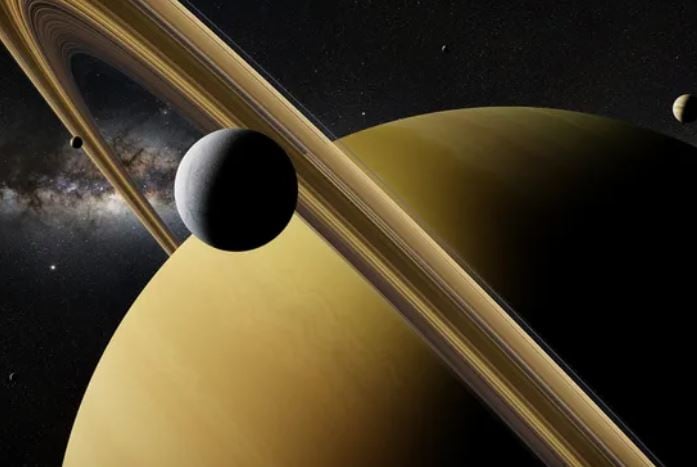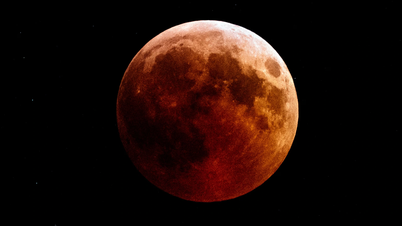On a clear night, if we look up at the sky, the brightest and largest object we can see is usually the moon. Unless we have the aid of a high-quality telescope, it is the only natural satellite that can be observed with the human eye. This has led many people to have a distorted view of how many moons there are and how common they are in space.
In fact, there are hundreds, even thousands, of natural satellites in our cosmic neighborhood, ranging from town-sized space rocks to giant objects that qualify as planets.
So how many moons have we discovered in our solar system so far? The answer depends on how we define "moon."
According to NASA, the International Astronomical Union (IAU) officially recognizes 416 planetary satellites orbiting the eight planets of the solar system. In addition, NASA also recorded 507 "small-body satellites" - that is, satellites of asteroids and dwarf planets. Including both types, the total number of natural satellites in the solar system is currently 923, as of March 2025.

Saturn has at least 274 moons - the most of any planet in the solar system. Photo: Getty.
However, according to astronomer Edward Ashton of the Institute of Astronomy and Astrophysics of Academia Sinica (Taiwan), this figure may be just “the tip of the iceberg”. In recent years, astronomers have discovered dozens of new satellites. He said technological advances will continue to accelerate the pace of new moon discoveries in the near future.
What is the moon?
“The simplest definition of a moon is an object that orbits a larger object that is not a star,” Ashton explains. However, he emphasizes that this is not the full definition.
For example, thousands of artificial satellites currently orbiting the Earth meet the above definition, but they are not considered moons because of their unnatural origin. These artificial satellites also have a finite lifespan, ending with re-entry and burning up in the Earth's atmosphere.
Additionally, some natural satellites, such as quasi-moons or mini-moons, are temporary satellites that do not actually orbit the planet. The size question is also important. Astronomer Brett Gladman (University of British Columbia, Canada) said that ring particles – small pieces of rock that orbit planets like Saturn and Uranus – do not count as moons, although they orbit the planet. He also emphasized that objects smaller than a few hundred feet, often called “ring moons” or “mini-moons,” have a very vague definition and are not officially recognized as moons.
Even recognized moons are controversial. Planetary moons fall into two groups: regular moons—generally larger, with circular orbits near their host planet’s equator; and irregular moons—smaller, with larger, more elliptical orbits. According to the Planetary Society, there are currently about 20 moons large enough to be circular due to their own gravity.
Moons of the planets
Starting closest to the sun, Mercury and Venus both have no real moons, having long since been stripped of potential satellites by the nearby gas giant. Venus has a pseudo-moon called Zoozve, but it doesn't count because it orbits the sun, not Venus.
Earth has only one official moon, but the planet also has at least seven crescent moons and occasionally additional mini-moons that last for about a year. These satellites are not counted, but some scientists think they could serve as temporary bases for interplanetary human travel.
Mars has two small moons, Phobos and Deimos, both just a few miles across and orbiting close to the red planet. Phobos is slowly falling into a lower orbit and is expected to collide with Mars in the future – unless it is torn apart first.
With the gas giants, the number of moons skyrockets. Jupiter currently has 95 moons, including four famous large ones: Callisto, Europa, Io, and Ganymede – the largest moon in the solar system. Saturn is even more numerous, with at least 274 moons, including six large ones: Titan, Mimas, and Enceladus.
Uranus and Neptune have 28 and 16 moons respectively, with a total of seven major moons.
Since the start of 2023, astronomers have discovered at least 190 new irregular moons around Saturn, 12 new moons around Jupiter, two around Neptune, and one around Uranus. This sudden increase is thought to be due to more modern telescopes that are able to detect smaller moons, especially irregular ones.
Ashton revealed that he and his colleagues are still waiting for confirmation from the IAU for some of their new moon discoveries.
Additionally, the number of moons could continue to increase if we discover more planets in our solar system. One example is “Planet Nine,” a hypothetical planet that could exist on the far edge of our solar system. If it exists, it could have multiple moons orbiting it. Scientists also speculate that some of the rogue planets—those pulled in from interstellar space by the sun—could have moons of their own.
Small body satellite
The 507 small moons NASA announced are still uncertain because the number of asteroids is constantly increasing. Some asteroids may have many small moons that are difficult to distinguish.
The IAU estimates that there are more than 100 other dwarf planets waiting to be discovered at the edge of the solar system, all of which may have moons. Like the giant planets’ moons, most of these bodies’ moons remain undiscovered, Ashton says. The total could be as large as the number of planetary moons.
However, not all astronomers agree. Gladman says that because many of the “host objects” are still unknown, it is difficult to give an exact number.
How many moons can there be in total?
There are currently more than 900 known natural satellites in the solar system. However, this number could increase significantly in the near future.
Gladman said previous studies have predicted that hundreds, even thousands, of asteroid moons could be discovered as telescopes continue to improve. While there is still a lot of uncertainty about the actual number, researchers are not afraid to make predictions.
Ashton believes that the total number of moons in the solar system could be as high as 10,000. However, the time it will take to find all of them remains an unsolved mystery.
Source: https://doanhnghiepvn.vn/cong-nghe/co-bao-nhieu-mat-trang-trong-he-mat-troi-cau-tra-loi-khong-phai-la-1/20250519015449051




![[Photo] Prime Minister Pham Minh Chinh attends the 80th anniversary of the founding of Voice of Vietnam Radio Station](https://vphoto.vietnam.vn/thumb/1200x675/vietnam/resource/IMAGE/2025/9/7/abdcaa3d5d7f471abbe3ab22e5a35ec9)
![[Photo] Impressive display booths of provinces and cities at the Exhibition 80 years of the Journey of Independence - Freedom - Happiness](https://vphoto.vietnam.vn/thumb/1200x675/vietnam/resource/IMAGE/2025/9/7/cd63e24d8ef7414dbf2194ab1af337ed)























![[Photo] General Secretary To Lam attends the 55th anniversary of the first television program broadcast](https://vphoto.vietnam.vn/thumb/1200x675/vietnam/resource/IMAGE/2025/9/7/8b8bd4844b84459db41f6192ceb6dfdd)


















![[Highlight] VIMC's mark at the National Achievement Exhibition](https://vphoto.vietnam.vn/thumb/402x226/vietnam/resource/IMAGE/2025/9/7/932133a54d8b4becad48ef4f082f3eea)






![[COMING UP] Workshop: Resolving concerns for Business Households about eliminating lump-sum tax](https://vphoto.vietnam.vn/thumb/402x226/vietnam/resource/IMAGE/2025/9/7/5627bb2d0c3349f2bf26accd8ca6dbc2)








































Comment (0)